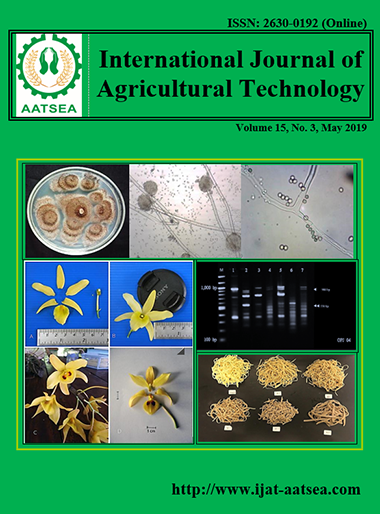Performance of tree stand growth and nutrient status of a reclaimed land
Main Article Content
Abstract
The evaluation of tree growth performance and their corresponding effect on soil nutrient status is very crucial in selection of suitable species for reclamation and revegetation of degraded lands for their prompt recovery. This study was therefore evaluated the growth performance and nutrient status of a 30.4 hectares’ land reforested by Newmont Ghana Gold Limited in 2002. Five 50 x 50 m plots were conducted in pure stands of Senna siamea, Tectona grandis, Cedrela odorata and mixed stand with an adjacent control plot. The 50 x 50 m plots were then divided into twenty-five (25) 10 x 10 m subplots from which five were randomly selected under each stand for growth performance and soil nutrient status assessment. The results showed significant differences in all growth and soil parameters measured among the stands. Among all the growth parameters measured Cedrela odorata stand generally recorded the highest growth followed by the mixed, Senna siamea and Tectona grandis stands respectively. The Cedrela odorata stand recorded a mean height of 17.29 m followed by 13.16 m, 12.89 m and 12.32 m for the Senna siamea, mixed and Tectona grandis stands respectively. Mean diameter values of 24.35 cm, 19.43 cm, 17.57 cm and 16.03 cm were recorded in Cedrela odorata, mixed, Senna siamea and Tectona grandis stands respectively. The highest levels of soil macro nutrient, pH (6.21), organic matter (6.05 %) and organic carbon (3.51 %) content were generally recorded under the Cedrela odorata stand. Generally, Cedrela odorata proved to be very useful tree species for reclamation of degraded lands.
Article Details

This work is licensed under a Creative Commons Attribution-NonCommercial-NoDerivatives 4.0 International License.
References
Acheampong, E. (2003). Sustainable livelihoods of forest fringe communities: Forests, trees and household livelihood strategies in southern Ghana. (PhD Thesis), University of Hull. England.
Chiti, T., Cerini, A., Puglisi, A., Sanesi, A. and Capperucci, C. (2006). Effect of associating an N-fixer species to monotypic Oak plantations on the quantity and quality of organic matter in mine soils. Geoderma, 61:35-43.
Domson, O. and Vlosky, R. P. (2007). A strategic overview of the forest sector in Ghana. Louisiana Forest Products Development Center, 81:2-5.
Dutta, R. K. and Agrawal, M. (2002). Effects of tree plantations on the soil characteristics and microbial activity of coal mine spoil land. Tropical ecology, 43:315-324.
Garcia-Saqui, J. (2007). Growth Rate of Tectona Grandis and Cedrela Odorata in Monoculture and Mixed Species Systems in Belize, Central America. University of Florida. (Ph.D. Thesis). United States of America.
Ghana, F. W. (2006). Forest Governance in Ghana–an NGO Perspective. A report produced for FERN by Forest Watch Ghana, pp1-3.
Hossain, M., Siddique, M. R. H., Rahman, M. S., Hossain, M. Z. and Hasan, M. M. (2011). Nutrient dynamics associated with leaf litter decomposition of three agroforestry tree species (Azadirachta indica, Dalbergia sissoo, and Melia azedarach) of Bangladesh. Journal of Forestry Research, 22:577-582.
Jahed, R. R., Hosseini, S. M. and Kooch, Y. (2014). The effect of natural and planted forest stands on soil fertility in the Hyrcanian region. Biodiversitas Journal of Biological Diversity, 15:206-214.
Koomson, D. (2011). Ecological integrity of a reclaimed site in Forest Resources Technology. (Bachelor of science Thesis). Knust-Sunyani. Ghana.
MoFA (2013). Tano North Technical Report on climatic, vegetation, edaphic and soil classification and suitability for Agriculture. Ministry of Food and Agriculture of the Republic of Ghana. Retrived from http://mofa.gov.gh/site/wp-content/uploads/2018/05/Agric%20in%20Ghana%20F&F%202016_Final.pdf.
Montagnini, F. (2000). Accumulation in above-ground biomass and soil storage of mineral nutrients in pure and mixed plantations in a humid tropical lowland. Forest Ecology and Management, 134:257-270.
Opoku, S. M. (2012). Growth and productivity of Khaya Grandifoliola in the Dry Semi-deciduous forest of Ghana: A Comparison in pure stands and in mixed stands (Ph.D. Thesis). Kwame Nkrumah University of Science and Technology. Ghana.
Orwa, C., Mutua, A., Kindt, R., Jamnadass, R. and Anthony, S. (2009). Agroforestry data base: a true reference and selecto ginde vergo 4,) Retrived from http:/www.worldagroforestry.org/sites/treedbs/ tree databases.asp.
Park, S. and Kang-Hyun, C. (2003). Nutrient leaching from leaf litter of emergent macrophyte (Zizania latifolia) and the effects of water temperature on the leaching process. Korean Journal of Biological Sciences, 7:289-294.
Pasieckzink, N. (2008). Invasive species compendium: detailed coverage of invasive species threatening livelihood and environment worldwide. Retrived from https://platform.cabi.org/Uploads/CABI/Events/GODAN/ISC%20brochure.pdf.
Piotto, D., Vıquez, E., Montagnini, F. and Kanninen, M. (2004). Pure and mixed forest plantations with native species of the dry tropics of Costa Rica: a comparison of growth and productivity. Forest Ecology and Management, 190:359-372.
Reid, R. and Stephen, P. (1999). The Farmer's log 1999. University of Melbourne, Departmen of Forestry, pp.5-8.
Richards, A. E., Forrester, D. I., Bauhus, J. and Scherer-Lorenzen, M. (2010). The influence of mixed tree plantations on the nutrition of individual species: a review. Tree Physiology, pp.35.
Sayyad, E., Hosseini, S. M., Mokhtari, J., Mahdavi, R., Jalali, S. G., Akbarinia, M. and Tabari, M. (2007). Comparison of growth, nutrition and soil properties of pure and mixed stands of Populus deltoides and Alnus subcordata. Silva Fennica, 40:27-35.
Wahyuni, S. Inenga, S. J. and Puspanningsih, N. (2016). Model for estimating above ground biomass of reclamation forest using unmanned aerial vehicles, Indonesian Journal of electrical engineering and computer Science, 4:586-593.
Wang, Q., Wang, S. and Huang, Y. (2008). Comparisons of litter fall, litter decomposition and nutrient return in a monoculture Cunninghamia lanceolata and a mixed stand in southern China. Forest Ecology and Management, 255:1210-1218.


